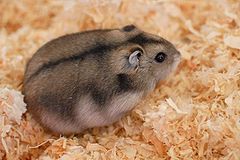Chomicznik
| Phodopus[1] | |||
| G.S. Miller, 1910[2] | |||
 Przedstawiciel rodzaju – chomicznik dżungarski (P. sungorus) | |||
| Systematyka | |||
| Domena | |||
|---|---|---|---|
| Królestwo | |||
| Typ | |||
| Podtyp | |||
| Gromada | |||
| Podgromada | |||
| Infragromada | |||
| Rząd | |||
| Podrząd | |||
| Infrarząd | |||
| Nadrodzina | |||
| Rodzina | |||
| Podrodzina | |||
| Rodzaj | chomicznik | ||
| Typ nomenklatoryczny | |||
Cricetulus bedfordiae O. Thomas, 1908 (= Cricetulus roborovskii Satunin, 1903) | |||
| Synonimy | |||
| Gatunki | |||
| |||
Chomicznik[4] (Phodopus) – rodzaj ssaka z podrodziny chomików (Cricetinae) w rodzinie chomikowatych (Cricetidae).
Zasięg występowania
Rodzaj obejmuje gatunki występujące w Azji[5][6][7].
Morfologia
Długość ciała (bez ogona) 70–103 mm, długość ogona 5–15 mm, długość ucha 8–16 mm, długość tylnej stopy 10–15 mm; masa ciała 19–28 g[6].
Systematyka
Etymologia
- Phodopus: gr. φως phos, φωδος phodos „bąbel, pęcherz”[8]; πους pous, ποδος podos stopa[9].
- Cricetiscus: rodzaj Critecus Leske, 1779 (chomik); łac. przyrostek zdrabniający -iscus[10]. Gatunek typowy: Cricetulus campbelli O. Thomas, 1905.
Podział systematyczny
Do rodzaju należą następujące gatunki[5][4]:
- Phodopus roborovskii (Satunin, 1903) – chomicznik malutki
- Phodopus campbelli (O. Thomas, 1905) – chomicznik zabajkalski
- Phodopus sungorus (Pallas, 1773) – chomicznik dżungarski
Przypisy
- ↑ Phodopus, [w:] Integrated Taxonomic Information System [online] (ang.).
- ↑ G.S. Miller. Two new genera of murine rodents. „Smithsonian Miscellaneous Collections”. 52, s. 498, 1910. (ang.).
- ↑ O. Thomas. On the small Hamsters that have been referred to Cricetulus phseus and campbelli. „The Annals and Magazine of Natural History”. Eighth Series. 19, s. 456, 1917. (ang.).
- ↑ a b Nazwy polskie za: W. Cichocki, A. Ważna, J. Cichocki, E. Rajska-Jurgiel, A. Jasiński & W. Bogdanowicz: Polskie nazewnictwo ssaków świata. Warszawa: Muzeum i Instytut Zoologii PAN, 2015, s. 240. ISBN 978-83-88147-15-9. (pol. • ang.).
- ↑ a b C.J. Burgin, D.E. Wilson, R.A. Mittermeier, A.B. Rylands, T.E. Lacher & W. Sechrest: Illustrated Checklist of the Mammals of the World. Cz. 1: Monotremata to Rodentia. Barcelona: Lynx Edicions, 2020, s. 340. ISBN 978-84-16728-34-3. (ang.).
- ↑ a b U. Pardiñas, P. Myers, L. León-Paniagua, N.O. Garza, J. Cook, B. Kryštufek, R. Haslauer, R. Bradley, G. Shenbrot & J. Patton. Opisy gatunków Cricetidae: U. Pardiñas, D. Ruelas, J. Brito, L. Bradley, R. Bradley, N.O. Garza, B. Kryštufek, J. Cook, E.C. Soto, J. Salazar-Bravo, G. Shenbrot, E. Chiquito, A. Percequillo, J. Prado, R. Haslauer, J. Patton & L. León-Paniagua: Family Cricetidae (True Hamsters, Voles, Lemmings and New World Rats and Mice). W: D.E. Wilson, R.A. Mittermeier & T.E. Lacher (red. red.): Handbook of the Mammals of the World. Cz. 7: Rodents II. Barcelona: Lynx Edicions, 2017, s. 281. ISBN 978-84-16728-04-6. (ang.).
- ↑ D.E. Wilson & D.M. Reeder (red. red.): Genus Phodopus. [w:] Mammal Species of the World. A Taxonomic and Geographic Reference (Wyd. 3) [on-line]. Johns Hopkins University Press, 2005. [dostęp 2020-11-20].
- ↑ Jaeger 1944 ↓, s. 172.
- ↑ Jaeger 1944 ↓, s. 180.
- ↑ Jaeger 1944 ↓, s. 114.
Bibliografia
- E.C. Jaeger: Source-book of biological names and terms. Wyd. 1. Springfield: Charles C. Thomas, 1944, s. 1-256. (ang.).
Media użyte na tej stronie
Autor: (of code) -xfi-, Licencja: CC BY-SA 3.0
The Wikispecies logo created by Zephram Stark based on a concept design by Jeremykemp.

